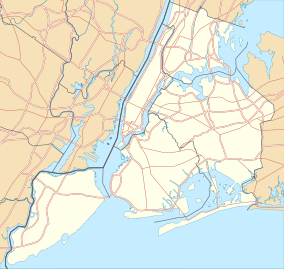
Flushing Meadows–Corona Park, often referred to as Flushing Meadows Park, or simply Flushing Meadows, is a public park in the northern part of Queens, New York City. It is bounded by I-678 on the east, Grand Central Parkway on the west, Flushing Bay on the north, and Union Turnpike on the south. Flushing Meadows–Corona Park is the fourth-largest public park in New York City, with a total area of 897 acres (363 ha).

The Unisphere is a spherical stainless steel representation of the Earth in Flushing Meadows–Corona Park, in the New York City borough of Queens. The sphere, which measures 140 feet (43 m) high and 120 feet (37 m) in diameter, was designed by Gilmore D. Clarke as part of his plan for the 1964 New York World's Fair.

Flushing is a neighborhood in the north-central portion of the New York City borough of Queens. The neighborhood is the fourth-largest central business district in New York City. Downtown Flushing, a major commercial and retail area centered around the intersection of Main Street and Roosevelt Avenue, is the third-busiest intersection in New York City, behind Times Square and Herald Square.

The Flushing Remonstrance was a 1657 petition to Director-General of New Netherland Peter Stuyvesant, in which some thirty residents of the small settlement at Flushing requested an exemption to his ban on Quaker worship. It is considered a precursor to the United States Constitution's provision on freedom of religion in the Bill of Rights. According to Kenneth T. Jackson, the Flushing Remonstrance was remarkable for four reasons:
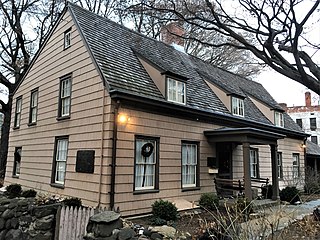
The John Bowne House is a house in Flushing, Queens, New York City, that is known for its role in establishing religious tolerance in the United States.

Queens Botanical Garden is a botanical garden located at 43-50 Main Street in Flushing, Queens, New York City. The 39-acre (16 ha) site features rose, bee, herb, wedding, and perennial gardens; an arboretum; an art gallery; and a LEED-certified Visitor & Administration Building. Queens Botanical Garden is located on property owned by the City of New York, and is funded from several public and private sources. It is operated by Queens Botanical Garden Society, Inc.

Kew Gardens Hills is a middle-class neighborhood in the middle of the New York City borough of Queens. The borders are Flushing Meadows-Corona Park to the west, the Long Island Expressway to the north, Union Turnpike to the south, and Parsons Boulevard to the east.

College Point is a working-middle-class neighborhood in the New York City borough of Queens. It is bounded to the south by Whitestone Expressway and Flushing; to the east by 138th Street and Malba/Whitestone; to the north by the East River; and to the west by Flushing Bay. College Point is a mostly residential ethnically diverse community with some industrial areas. The neighborhood is served by several parks and contains two yacht clubs.

New York's 6th congressional district is a congressional district for the United States House of Representatives in New York City, located entirely within Queens. It is represented by Democrat Grace Meng.
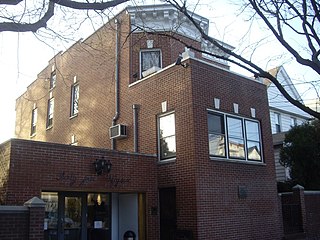
The Louis Armstrong House, formally known as 34-56 107th Street, is a historic house museum in Corona, Queens, New York City. It was the home of Louis Armstrong and his wife Lucille Wilson from 1943 until his death in 1971. Lucille gave ownership of it to the city of New York in order to create a museum focused on her husband.

The Old Quaker Meeting House is a historic Quaker house of worship located at 137-16 Northern Boulevard, in Flushing, Queens, New York. The site, built in 1694, is the oldest house of worship in New York City, one of the three oldest continuously active sites of religious activity in North America, and the second oldest Quaker meeting house in the nation. It was declared a National Historic Landmark in 1967 and a New York City designated landmark in 1970. Today, it still serves as a Quaker Meeting, with meetings for worship taking place every Sunday.

The Lewis H. Latimer House, also called the Latimer House or the Lewis Latimer House, is a historic house located at 34-41 137th Street in Flushing, Queens, New York City. It was constructed in the Queen Anne style of architecture between 1887 and 1889 by the Sexton family. It served as the home of the African-American inventor Lewis Howard Latimer from 1903 to 1928, and is now operated as a museum dedicated to the inventor's work. In addition, this museum-house also illuminated the life and achievements of other black scientists. The house remained property of the Latimer family until 1963. Currently, the Lewis H. Latimer House is owned by the New York City Department of Parks and Recreation, operated by the Lewis H. Latimer Fund, Inc., and is a member of the Historic House Trust.
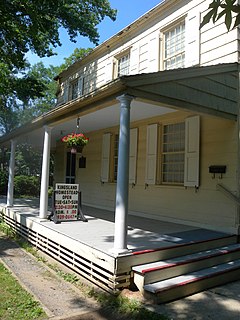
Kingsland Homestead is an 18th-century house located in Flushing, Queens, New York City. It is the home of the remains of The Weeping Beech, a landmark weeping beech tree, believed to have been planted in 1847. The homestead is also close to the 17th-century Bowne House, the location of the first Quaker meeting place in New Amsterdam. The homestead is operated by the Queens Historical Society, whose quarters are inside; the homestead is open to the public as a museum. The Kingsland Homestead is a member of the Historic House Trust, and is both a New York City designated landmark and a National Register of Historic Places listing.

Grace Meng is an American lawyer and politician serving as a Democratic member of the United States House of Representatives, representing New York's 6th congressional district in the New York City borough of Queens, which includes Bayside, Flushing, Forest Hills, Fresh Meadows, Glendale, Kew Gardens, Maspeth, Middle Village, and Rego Park. Previously, she served as a member of the New York State Assembly, representing the 22nd assembly district in Flushing, Queens. She is the first Asian American to be elected to Congress from New York.

The Free Synagogue of Flushing is a historic synagogue located at 41-60 Kissena Boulevard in Flushing, Queens, New York City. It was added to the National Register of Historical Places in 2009. Its establishment is based on the free synagogue movement, started by Stephen Samuel Wise.

Kissena Creek is a buried stream located in the neighborhoods of Flushing, Fresh Meadows, Hillcrest, and Kew Gardens Hills in the New York City borough of Queens. Kissena Creek originates in a now-filled swamp within Kew Gardens Hills and Pomonok in central Queens, flowing east to Hillcrest. The creek then travels mostly north and west, largely flowing beneath Kissena Park Golf Course, Kissena Park, Kissena Corridor Park, and Queens Botanical Garden, before merging with the Flushing River in Flushing Meadows–Corona Park.
The following is a timeline of the history of the borough of Queens in New York City, New York, USA.
Playground Seventy Five is a public park located on 160th Street and 75th Avenue in the Hillcrest neighborhood of Queens, New York. It was acquired by the New York City government in 1929 as part of land condemnations for the construction of Public School 154. The undeveloped section of the block was reserved as a schoolyard and developed as a playground in 1954.
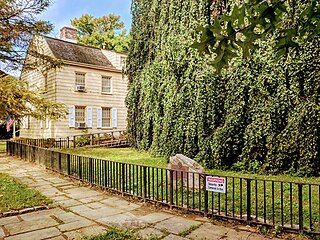
The Weeping Beech was a historic tree located at Weeping Beech Park in Flushing, Queens, New York City. It was the mother of all European weeping beeches in the United States.

